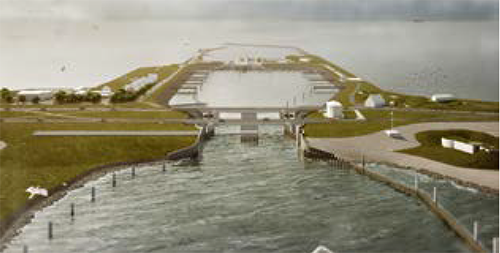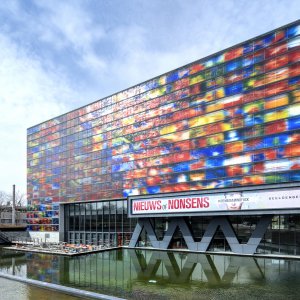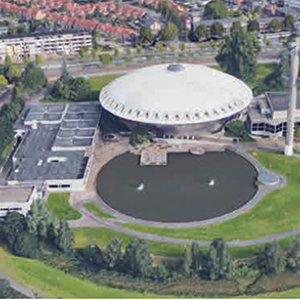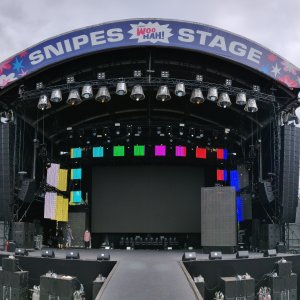De Nieuwe Afsluitdijk - Renovation from 2018-2020
The Afsluitdijk is a 32-kilometer-long flood defense that closes off the IJsselmeer from the Wadden Sea. At the same time, it is a dam that connects the provinces of Noord-Holland and Friesland. An important traffic route, A7, runs along the Afsluitdijk. The Afsluitdijk has been built after a large number of dikes along the Zuiderzee broke through due to a heavy storm in 1916. In 1927, the construction was started.
On May 28th, 1932, at 13:02 hours, the Vlieter (the last hole in the Afsluitdijk) was closed. Thanks to the dike, the sea is kept outside and the land borders and the Netherlands has become much safer. A breach of the Afsluitdijk can have serious consequences. In order to continue to protect the inland in the future, the dike will be given a refurbishment. From 2018 to 2022, the consortium Levvel (collaboration between BAM, Van Oord, and Rebel) works on the renewal of the Afsluitdijk commissioned by Rijkswaterstaat. The renovation consists of:
• Reinforcing the dike body, guards, and the sluices (flood risk management);
• Increasing the capacity to drain water (water management);
• Improving and maintaining the A7 motorway;
• Projects in the field of economics, nature, and sustainable energy (by the initiative of De Nieuwe Afsluitdijk).
Dike reinforcement
On the side of the Wadden Sea, the dike is raised and reinforced with a new covering. Levvel uses innovative and specially designed concrete elements for the Afsluitdijk, the so-called Levvel blocs. These blocks weigh approximately 6,500 kilograms each, are very strong, have a wave-inhibiting effect, and are easy to install. About 100 blocks a day are roduced in Harlingen in a fully automated process and transported by ship to the dike, and approximately 75,000 Levvel blocs are placed in total from a crane pontoon. Because of the symmetry and continuous placement, the block gives a calm image that strengthens the tight, autonomous character of the sluices (Figure 1).
Water drainage
The sluices at Den Oever and Kornwerderzand transport excess water from the IJsselmeer to the Wadden Sea. If the water in the Wadden Sea is at low tide, the sluices open. The water from the IJsselmeer then flows to the Wadden Sea; under 'free fall', gravity does the work. The capacity to drain water by the sluices is no longer sufficient. Therefore, the water discharge capacity must be increased.
Figure 1: Section of the new Afsluitdijk
The lock complex at Den Oever will be extended by building new sluices at the intermediate islands (Figure 2). Draining is not possible when water is at a high level in the Wadden Sea. That is why Levvel builds two large pumping stations in Den Oever. The pumps have a very low energy consumption and are fish-friendly. The energy for the pumps is generated in Figure 1: Section of the new Afsluitdijk a sustainable manner by means of solar energy. With these measures, the Afsluitdijk is resistant to the power of the water up to at least 2050.
Flush when possible, pump if necessary
Flushing is, and remains after the renovation, the preferred method to drain large volumes relatively quickly. The pumps are only used when it is really necessary: flush when possible, pump if necessary. Especially in peak situations, this is important. However, it is crucial to be able to use an additional method that can be used at all times, even when flushing is temporarily not possible. Pumps can work against gravity; by pumping, water can be drained if the tide in the Wadden Sea is higher than in the IJsselmeer.
Fish migration
The Fish Migration River is an opening in the Afsluitdijk where migratory fish can swim through to reach the IJsselmeer from the Wadden Sea and vice versa. Migratory fish need both fresh and salt water for their life cycle. Due to dikes and dams, such as the Afsluitdijk, this is hardly possible. This is one of the important reasons why the numbers of migratory fish are lower than before the Afsluitdijk.
Figure 2: New design lock Kornwerderzand
A solution was devised for this: the Fish Migration River. With the Fish Migration River, it is aimed for that the obstacle to migratory fish is eliminated with De Nieuwe Afsluitdijk. Millions of fish are now lying in the Wadden Sea waiting for the sluices. They smell the fresh water and want to go inside. However, the current flow is usually too strong for these migratory fish to swim against. A permanent opening via the Fish Migration River trough the Afsluitdijk should make it possible for these migratory fish to swim freely from saltwater to freshwater. Rijkswaterstaat is also taking measures to stimulate fish migration between the Wadden Sea and the IJsselmeer. For example, a fish friendly lock management is being applied and a fish passage is being constructed at Den Oever. Together, these measures ensure that the number of migrating fish increases. The Fish Migration River is about three kilometers long in the IJsselmeer. Due to its length, the river can be open for a long time during the changing of tides. The salt water with the fish (larvae) can flow freely into the river at high tide. Because of the length it takes a long time before the salt water reaches the end of the river. The length also ensures gradual change in the fresh-salt transition and thus mimics the natural situation best. The entrance of the Fish Migration River is connected to the drain basin, where the fresh Ijsselmeer water is discharged. Fish 'smell' this and are attracted by it. By tidal action fresh water flows to the Wadden Sea when the tide is low. In this way, fish can find the entrance to the fish migration river. The sway character of the Fish Migration River creates a difference in flow rates, which is important for fish to be able to hide, forage and rest. A slow flow rate, designed in the river, also gives weak swimmers the chance to migrate. They also let themselves be drawn by the flood stream. The smart thing about the design of the Fish Migration River is that it is possible for fish to migrate, but keeps salt water from flowing into the IJsselmeer (Figure 3).
Unique project with global appeal
The Fish Migration River is a system that stays close to nature and that operates optimal for fish and the ecosystem. Worldwide, there are several comparable situations where this would be a solution. Therefore, it is a unique project for the Dutch hydraulic engineering sector with an international appeal.
Figure 3: Top view on the fish migration river
Recreation
In order to facilitate visitors better, De Nieuwe Afsluitdijk includes a number of initiatives. For example, there will be an extra bicycle path on the Wadden Sea side, along the entire dike. The space around the Monument of Dudok will be improved and made more accessible to the public. The current pedestrian bridge will be relocated, strengthening the vertical character of the monument (unique on the dike). At Kornwerderzand, there will soon be a new walking route where pedestrians can walk to the Vismigration river.
A starting point for wider visit
New for visitors to the Afsluitdijk is the Wadden Center. Here, you get a total experience of the Unesco World Heritage Wadden Sea, the Fish Migration River, the IJsselmeer area, and the Afsluitdijk itself. A visit to this interactive center gives a good picture of the surroundings, but also of the many hydraulic engineering and other innovative projects that will be realized in the coming years.◄
References:
[1] www.deafsluitdijk.nl
Figures:
Header,3 De provincie Fryslân
1,2 www.deafsluitdijk.nl










